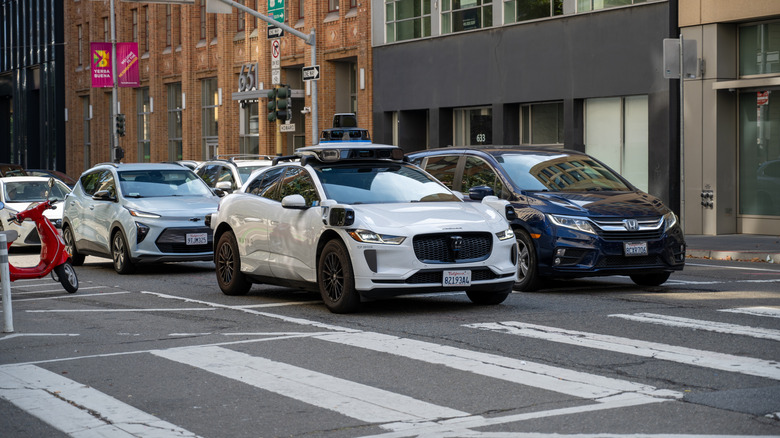Waymo Is Expanding Its Robotaxi Fleet To These Major US Cities
At one time, you probably only saw self-driving vehicles, whether in testing or use by customers, fairly close to Silicon Valley. Now, companies like Waymo operate fully autonomous vehicles in cities all over the country. Some of these cities include Atlanta, Austin, and New York City. If you're not familiar, Waymo is a ride-hailing company, similar to a taxi service, available primarily through the Waymo app. However, depending on the city, you can book a Waymo cab through Uber. You summon a ride, and it will take you to your destination, no drivers necessary. According to the company, Waymo cars have traveled autonomously on public roads for over 100 million miles and successfully completed more than 10 million paid rides. So, it's not surprising the company is expanding into at least three more U.S. cities.
In November, the Waymo blog announced that passengers can soon hail Waymo self-driving taxis in Las Vegas, San Diego, and Detroit. However, residents won't be able to access the service at first. The blog states the autonomous cars first need to get acquainted with "[Detroit's] historic streets" before they can accommodate passengers. Meanwhile, service in Las Vegas is expected to roll out in December, whereas San Diego won't receive the green light until next year. Waymo also announced it's heading to London in 2026, the company's first operating city in Europe. Waymo already expanded internationally into Tokyo, but Japan's residents can't hail a ride just yet. The company has made quite some progress since 2020, when it opened fully autonomous rides to the public in Phoenix. If you're in or near the aforementioned cities, you may soon have a chance to take one of the innovative autonomous rides to and from various destinations.
How reliable are Waymo robotaxis?
According to Waymo's Safety Impact reports, Waymo's services are "already making roads safer in the places where [they] currently operate." The company's autonomous cars are allegedly "better than humans at avoiding crashes that result in injuries." According to Waymo, when compared to the average human driver, their robotaxis experienced 91% fewer crashes that resulted in "serious injuries or worse", 79% fewer crashes that required airbag deployment, and 80% fewer crashes that caused regular injuries. Of course, Waymo also pointed out its driver never gets impaired (drunk or high on drugs, legal or otherwise) or distracted.
Waymo cars use Light Detection and Ranging (Lidar) tech and radar to visualize their surroundings, then combine the results with a host of technologies such as cameras, sensors, and computational capabilities. Testing is also rigorous and carried out extensively before Waymo rolls out its autonomous taxis in any location. The company has stated it ensures all systems pass "internal safety readiness criteria" and follow "all applicable state laws and federal regulations for testing." In 2024, Waymo started using employees to test its self-driving vehicles on freeways. So, we might see these robotaxis pretty much everywhere, including highways and byways, not just on city roads. Sometimes, Waymo cars even handle Uber Eats meal delivery services for Phoenix residents. If you live in available areas, yes, your food could be delivered by an autonomous vehicle. At least you don't have to worry about a driver eating your fries or drinking your milkshake, right?

